

Australia - The Gold Rush & The Eureka Stockade for Kids - FREE Presentations in PowerPoint format, Free Interactives and Games. Gold rush: level 2. Australian gold rushes. An Australian gold diggings circa 1855.

Gold Rush in Australia! The transportation of convicts to Australia was phased out between 1840 and 1868.
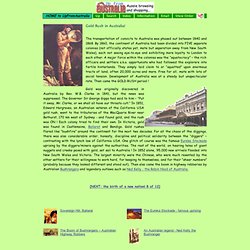
By 1860, the continent of Australia had been divided into FIVE separate colonies (not officially states yet, mate but seperation away from New South Wales), each not seeing eye-to-eye and exhibiting more loyalty to London to each other. A major force within the colonies was the “squatocracy” – the rich officers and settlers a.k.a. opportunists who had followed the explorers into fertile hinterlands. They simply laid claim to or “squatted” upon enormous tracts of land, often 20,000 acres and more. Free for all, mate with lots of social tension. Development of Australia was at a steady but unspectacular rate.
Gold was originally discovered in Australia by Rev. [NEXT: the birth of a new nation! Australian Gold Rush: 1850. The bonanza in California was only the beginning.
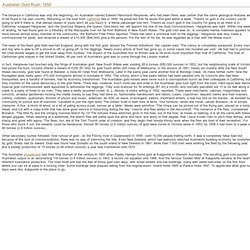
An Australian named Edward Hammond Hargraves, who had been there, was certain that the same geological features were to be found in his own country. Returning on the boat from California late in 1850, he predicted that he would find gold within a week. 'There's no gold in the country you're going to and if there is, that darned Queen of yours won't let you touch it,' a fellow passenger told him. Australian Gold Rush. Sovereign Hill Education - Research Notes. Welcome to Sovereign Hill Education Victoria’s 1850s goldrush heritage is alive, exciting and very hands-on at Sovereign Hill with creative, stimulating and interactive experiences for school students and kindergarten classes.

Students experience Sovereign Hill indoors, outdoors, above-ground and below-ground, giving a tremendous variety for school excursions and ensuring an action-packed, fun day. Sovereign Hill Education Sovereign Hill Education provides programs that are developed and delivered by Sovereign Hill Education officers, who are all experienced teachers.
We provide unique on-site sessions, "Discover It Yourself" programs and education materials suitable for all students and designed to achieve Find out more Costumed Schools Program. Find, mines, rewards, locations, South Australian Gold Rush. Australian History: Turn Back Time. Australia's migration history timeline. Era: 1840 - 1900Cultural background: Chinese, EnglishCollection: Powerhouse MuseumTheme:Gold Government Labour Movement Miners Riots Settlement.
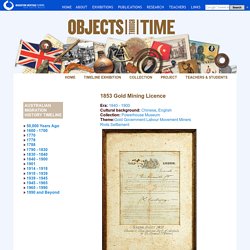
Gold Rush in Australia! Find, mines, rewards, locations, South Australian Gold Rush. Gold rush. Sailing to California at the beginning of the Gold Rush A gold rush is a period of feverish migration of workers to an area that has had a dramatic discovery of gold deposits.
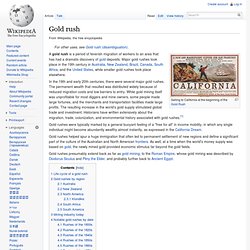
Major gold rushes took place in the 19th century in Australia, New Zealand, Brazil, Canada, South Africa, and the United States, while smaller gold rushes took place elsewhere. In the 19th and early 20th centuries, there were several major gold rushes. The permanent wealth that resulted was distributed widely because of reduced migration costs and low barriers to entry. While gold mining itself was unprofitable for most diggers and mine owners, some people made large fortunes, and the merchants and transportation facilities made large profits. Gold rushes were typically marked by a general buoyant feeling of a "free for all" in income mobility, in which any single individual might become abundantly wealthy almost instantly, as expressed in the California Dream.
Life cycle of a gold rush[edit] Australia[edit] Australian gold rush timeline, HSIE, Discovering gold, Gold! Year 6, NSW. The first major mineral discovery - gold - was a watershed (a turning point or landmark) for Australian society.

The initial stages of the gold rush were responsible for tremendous changes in the community, bringing Australia's first great waves of immigration from countries other than England and Ireland. Ambitious prospectors from Asia, Europe and America made the trek to the goldfields of Ballarat and Bendigo in Victoria, and Bathurst in New South Wales, in the hope of striking it rich. This influx of people brought many social changes, including an increase in racial tensions with the persecution of some groups, notably the Chinese. Government Surveyor James McBrien discovers traces of gold in the Fish River, east of Bathurst. Explorer and geologist Paul de Strzelecki discovers small amounts of gold in silicate near Hartley in the Blue Mountains.
The 1840s Early gold discoveries were greeted with fear. Gold! Australian gold rush timeline, HSIE, Discovering gold, Gold! Year 6, NSW. Sovereign Hill. The gold diggings Set in the Australian 1850s, the complex is located on a 25-hectare site that is linked to the richest alluvial gold rush in the world.
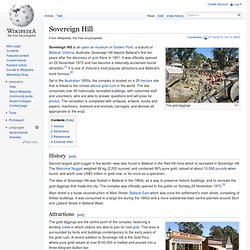
The site comprises over 60 historically recreated buildings, with costumed staff and volunteers, who are able to answer questions and will pose for photos. The recreation is completed with antiques, artwork, books and papers, machinery, livestock and animals, carriages, and devices all appropriate to the era2. History[edit] Australia History for Kids - FREE Presentations in PowerPoint format, Free Interactives and Games. Eureka Stockade. The Eureka Flag based on the constellation of the Southern Cross.
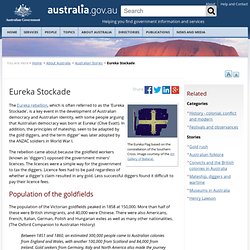
Image courtesy of the The , which is often referred to as the 'Eureka Stockade', is a key event in the development of Australian democracy and Australian identity, with some people arguing that Australian democracy was born at Eureka' (Clive Evatt). In addition, the principles of mateship, seen to be adapted by the gold diggers, and the term digger' was later adopted by the ANZAC soldiers in World War I. The rebellion came about because the goldfield workers (known as 'diggers') opposed the government miners' licences. The licences were a simple way for the government to tax the diggers.